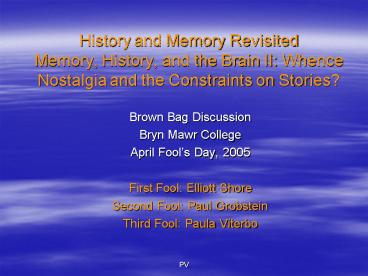History and Memory Revisited Memory, History, and the Brain II: Whence Nostalgia and the Constraints - PowerPoint PPT Presentation
1 / 10
Title:
History and Memory Revisited Memory, History, and the Brain II: Whence Nostalgia and the Constraints
Description:
April Fool's Day, 2005. First Fool: Elliott Shore. Second Fool: Paul Grobstein. Third Fool: Paula Viterbo. ES. April Fool's Day. and. Nostalgia. ES ... – PowerPoint PPT presentation
Number of Views:271
Avg rating:3.0/5.0
Title: History and Memory Revisited Memory, History, and the Brain II: Whence Nostalgia and the Constraints
1
History and Memory RevisitedMemory, History, and
the Brain II Whence Nostalgia and the
Constraints on Stories?
- Brown Bag Discussion
- Bryn Mawr College
- April Fools Day, 2005
- First Fool Elliott Shore
- Second Fool Paul Grobstein
- Third Fool Paula Viterbo
2
- April Fools Day
- and
- Nostalgia
3
What Paul and Elliott concluded in November
(Memory and the Brain I)
- Re. memory
- There is nothing in our brains or elsewhere in
our bodies that contains complete memories of
experiences (stories) - There are, however, traces (changes in the
neurobiological system) that occur as a result of
experiences - What we call memories are re-creations, stories
about past experiences, based on traces. A memory
(story) is created anew each time one remembers.
Memories are constructed in the present from past
traces. - Re. history
- History is also a re-creation of the past in the
present - History is not a guide to the future because it
is the current processing of past memories in
ways that appear useful in the present
4
Leftover questions and pointers to possible
answers
- What are those traces in the brain? Can we
understand psychological and cultural
explanations in neurobiological terms? - Are there limits / constraints to the stories we
tell ourselves about the past? - Are there time-independent memories (knowledge)?
Individual vs. species memory - Three ways to think about constraints on stories
- Neurological (Paul Paula)
- Psychological (Azade)
- Cultural (Kalala)
5
Neurobiological constraints the bipartite brain
the role of the neocortex
- There is a part of the brain (upper brain,
neocortex) that aspires to coherent stories,
and it tries to fit new input (from the rest of
the brain) into the coherent structures it has
(hence a propensity, among humans,
for nostalgia). Its not, then, so much what
sticks as what is (and is not) incorporated into
stories that matters. - http//serendip.brynmawr.edu/sci_cult/mentalhealth
/neuropsychotherapy/31march05/
6
The Relation between Memory and History
- Events
- Brains
Traces in the brain (patterns of firing neurons)
Primary sources
Individual memory Neurobiology Psychology Cognitiv
e science
Collective memory Alternative histories Psychology
Sociology Anthropolgy Literature History
Official history History
Individual self-identity After playing and
replaying them, we become our memories
Collective identity Nationalisms
7
Complicating the model
- Neither memory nor history are faithful replicas
of the past, nor infallible guides to the
present. BUT they are based on some kind of
record of the past. Memories are incomplete and
interpretive, processed in the brains lower
module. Used by both the lower and upper
brain, memory and history provide some kind of
guide to the present. In other words, humans
learn. - Both memory and history are recreated from traces
(neurological, historical sources). BUT traces
need to be interpreted (by the brains upper
module) in order to become explicit memories or
histories. AND not all interpretations are
possible.
8
Complicating the model
- Stories are constrained by the brains internal
environment (neurological, genetic), as well as
its external environment (cultural, social). - Like most historians, brains (or their upper
modules) are contextualists (not extreme
constructionists). And like a maligned minority
of historians, they are presentists (they
interpret the past in the light of the present). - BUT in the hands of contextualist historians (or
their upper modules), history can be a guide to
the future. Although some presentist biases are
inevitable, historians are trained to interpret
the past as much as possible in its own context.
Comparative contextual analyses enables them to
use (with limitations) the past as a guide to the
future.
9
Whence nostalgia?
- Psychological / cultural explanations
- Inertia
- Fear of change / loss
- Mistrust of unknown future
- The brains upper module values the coherence
and stability of the stories it constructs - Symmetry between remembrance (nostalgia) and
forgetfulness (painful and useless memories) - Neurobiological explanations
- The brain works in the present, based on traces
from the past. The brain constructs stories that
transform the past into the present. - The brain does not care about the future.
- Memories used over and over again are reinforced
in the brain (neurological pathways genetic
encoding) - Conservation of energy?
- Evolutionary explanations
- Is nostalgia adaptive? Does it conserve energy?
- What makes memories stick? (genetic explanations)
10
Return to Summary of Brown Bag Discussion































